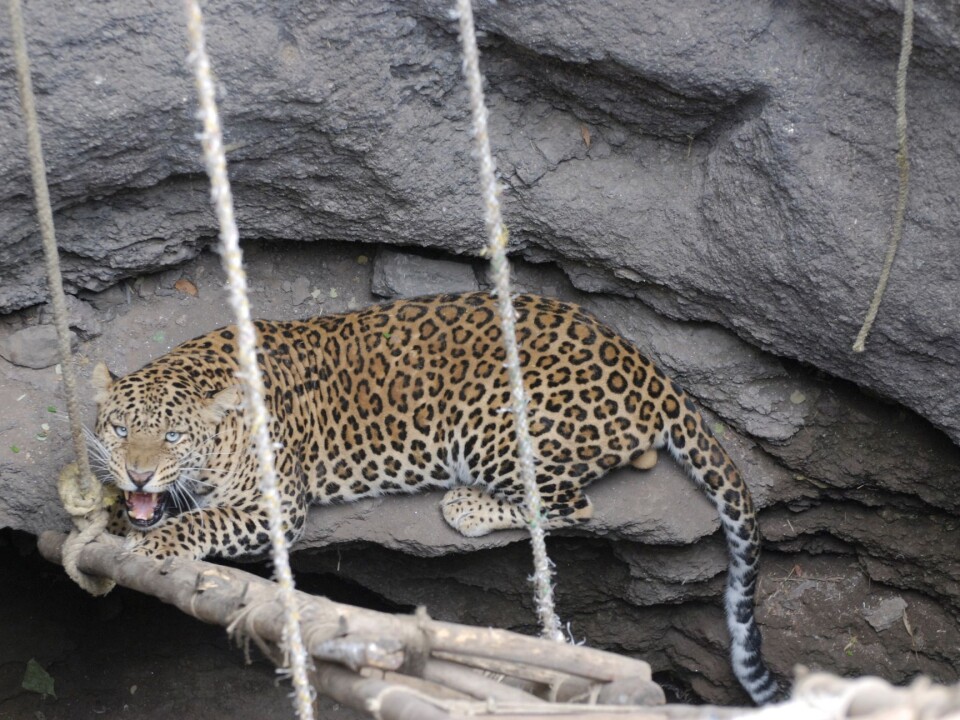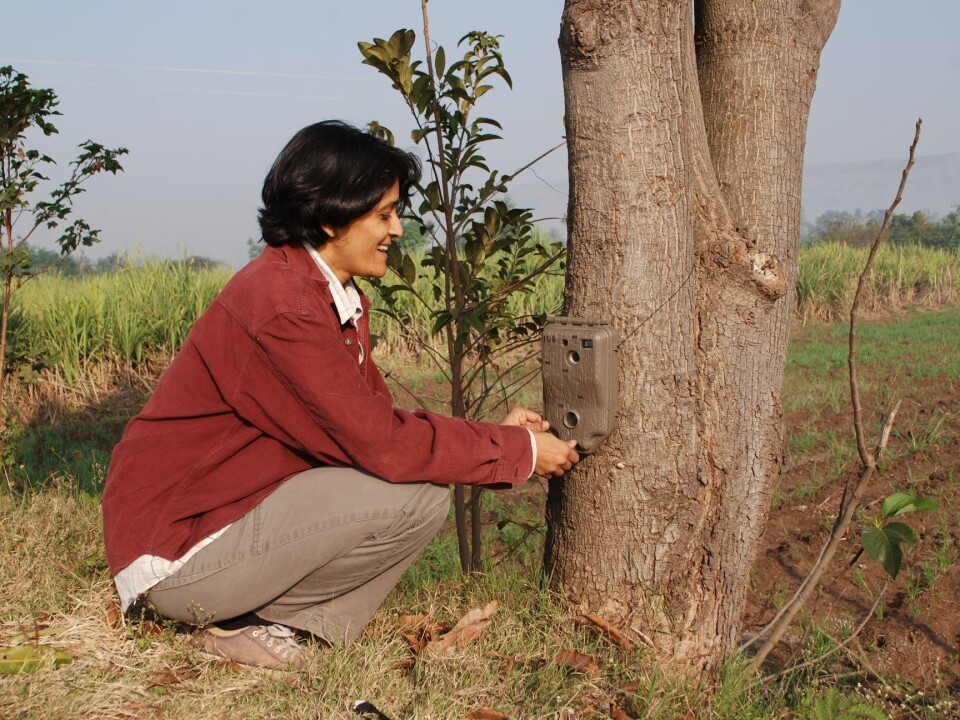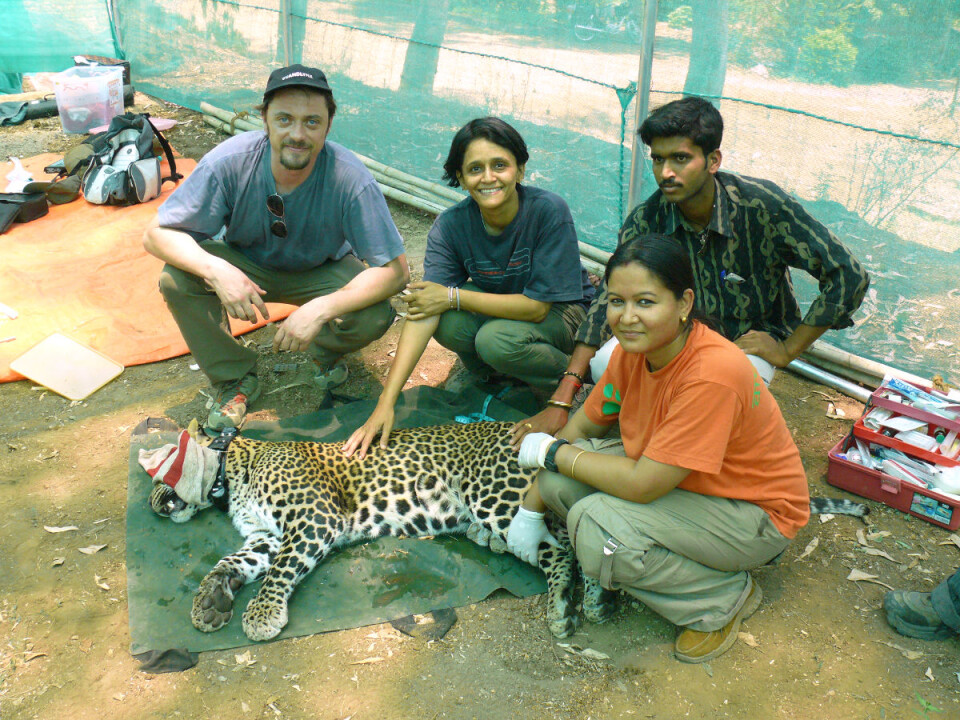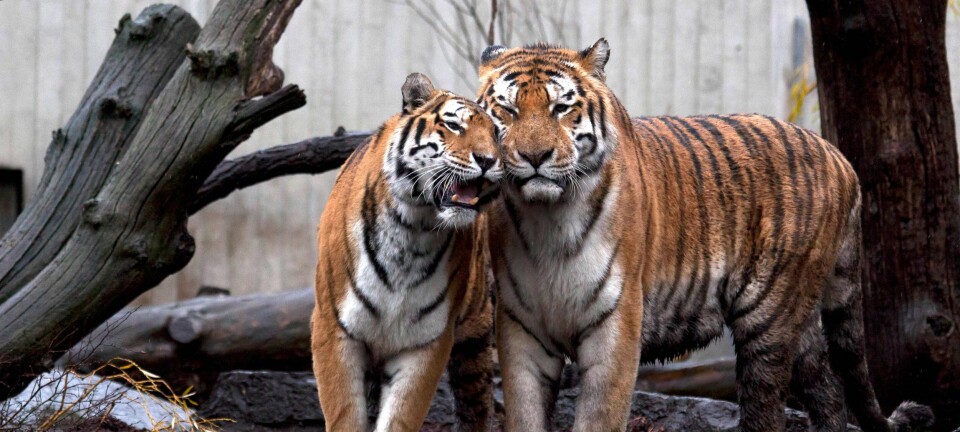This article was produced and financed by NINA - Norwegian Institute for Nature Research

GPS collared leopard becomes movie star
Poop, photo traps and GPS collars have revealed how leopards and people in India share the same space. The adventures of one particular leopard inspired the making of a Bollywood feature film.
Denne artikkelen er over ti år gammel og kan inneholde utdatert informasjon.
When leopards suddenly started attacking and killing people in the peaceful Indian valley of Junnar in the early 2000s, biologist Vidya Athreya asked herself why. Where did all the leopards come from? Why did the attacks start now?
Moreover, how could people and leopards live side by side without causing problems for each other in the neighboring area of Akole?
In the recently published popular science booklet Waghoba tales: Adventures in Leopard land which summarises a series of recent scientific articles Athreya tells the fascinating story of how she uncovered the secrets of these big, urban cats with the help of two Norwegian researchers and a local Indian field assistant. And how the research inspired the making of a Marathi feature film.
A stressed leopard in an unfamiliar territory
As it turned out, the onset of the killings in Junnar matched the onset of trapping and releasing leopards from farmlands and moving them away to adjoining forests or the nearest district boundary.

The general perception among people was that the leopards should live in forests, and that they had started roaming around villages due to loss of forest habitat and prey. When local farmers reported losing livestock, local officials caught and released many leopards.
Some leopards returned home, while others started causing problems near the release sites, often in areas where people had always lived with wildlife without any prior attacks.
"To survive in fragmented areas heavily affected by humans, the leopard needs to know the area in detail. When moved to a new area, they do not stand a chance. Then you will have a stressed leopard in an unfamiliar territory," researcher John Linnell from the Norwegian Institute for Nature (NINA) research explains.
A stressed leopard is a potentially aggressive and dangerous animal. He does not know where to hunt or to hide. Some might also be traumatized after being trapped, with hundreds of screaming people surrounding them, rattling the cage and poking them with sticks.
Trapping the spots
The relocation program explained the attacks, but another question remained; how is it possible for leopards and humans to share the same space without hurting each other in the first place? To find out, Athreya went to study the situation in Akole. She teamed up with John Linnell from NINA, Morten Odden from Hedmark University College in Norway and a local farmer, turned field assistant, Ashok Ghule.

Over a five year period they shed light on questions like “What do these leopards eat?”, “How big are their territories?” and most importantly “How do leopards and people adapt to living together?”
Since no two leopards have an identical arrangement of spots, the researchers use the spots to recognize individuals. They set up camera traps, and managed to get 80 photos of leopards, among which they identified at least eleven adult leopards. As it turned out, the Akole valley, which has at least 300 people per square kilometre, houses five leopards per 100 square kilometres.
Dogs on the menu
By collecting leopard poop, the researchers gained new insight into the diet of these farmland leopards.
"On this job, there is one question you don’t want to be asked: “What are you doing?” Everyone was inquisitive. Were we itinerant salesmen? Were we surveying land, water, or mobile phone towers? When I answered truthfully, some were shocked while others smirked. Frequently, I gave ludicrous answers – and that made the otherwise smelly and tedious work more fun," research assistant, farmer and forest watcher Ashok Ghule recounts (from Waghoba tales: Adventures in leopard land)

The diet proved to consist mainly of domestic animals, and the title of the published article “A cat among the dogs (…)” describes it well. Dogs make up almost half their diet, but they also eat goats, sheep and pigs. Most farmers protect their livestock by keeping them indoors during the night, leaving the leopards with a limited menu.
"We have a different relationship with our dogs in many other parts of the world. There are many stray dogs in India, even if most of them do have an owner," Linnell explains.
Resting on rooftops and giving birth next to a school
So, how did the leopards manage to live side by side with people, mostly unseen? The researchers put GPS collars on some of the leopards to reveal their movement patterns.
"We found that on average they were only 200 meters away from houses during daytime. During the night, they got even closer, on average only 100 meters from houses," Linnell explains.

The leopards were very clever at using the landscape to their advantage. High and dense crops like sugar cane and corn helped them get from A to B unseen. Some of the animals were town leopards, walking the streets and resting on rooftops. One leopard even gave birth in a sugarcane field 100 meters from the front entrance of a school.
"While it was fascinating to see what the animals were doing, that year was perhaps the most stressful period of my fieldwork," Vidya Athreya recounts.
Being most active during nighttime helped the leopards keep a low profile, giving them a cloak of invisibility, as Odden puts it. There is not much nightlife in Akole, as most people retire indoor after dark.
During daytime, the leopards hide in thick vegetation, and lie low even if people are close enough to step on their tails. Most of the time the villagers are unaware of their presence, but because of the GPS collars, we now know more about the secretive nocturnal lives.
The small size of the territories came as a surprise.
"The average leopard territory was only ten square kilometers, Linnell explains, and adds that a Norwegian lynx, which is about a quarter the size of a leopard, uses from 500 to 2000 square kilometres for a comparison".
Ajoba - the movie star
Quite often, leopards fall into one of the numerous open agricultural wells. This is what happened to the leopard that would soon be known as Ajoba. One day he was chasing a dog, and they both fell into a well. The normal procedure when a leopard falls into a well is to build a bamboo ladder and get him out of there. The researchers took the opportunity to put a GPS collar on him, hoping he would stay in the area so that they could monitor him
That was not Ajoba’s plan. Instead, he took off and went 150 kilometres straight to the metropolis of Mumbai, crossing highways and railway tracks, and swimming across a river, not hurting a single human. There he settled down in Sanjay Gandhi national park in the middle of the city, where he became quite famous.
"We were a bit nervous following him, as there had been some conflicts between leopards and people there," Linnell admits.
Ajoba lost his GPS collar after a short time, and the story could have ended here, had he not been hit by a car and injured several years later. The driver picked him up, put him in the car and headed for the vet. Unfortunately, Ajoba’s journey ended before they got that far. However, the story continued, and his life and the knowledge revealed by this intriguing research project, inspired the making of the Marathi feature film “Ajoba”.
Accepted by their human neighbors
Linnell underlines that it is important to remember that there are areas in India where the relationship between people and leopards is less peaceful, and to acknowledge that things sometimes go terribly wrong. Like in Junnar.
The studies in Akole show that the leopard is no stranger to populated areas. Leopards living in farmlands and towns are breeding populations, not lost or straying from elsewhere. They seem to thrive in in these populated, rural areas. That is, as long as they are not unnecessarily relocated by people. The GPS collared leopards demonstrate how people and leopards can share the same place without hurting each other as long as people tolerate their feline neighbors and take basic precautions.
"Even if people are not particularly happy to have the leopards lurking around their houses in Akole, you hear almost no complaints about it. They accept the leopards as part of life," Linnell says.
Scientific links
- Ghule, A., Athreya, V., Linnell, J., Odden, M. and Lenin, J. (2014) Waghoba tales: Adventures in lepard land. NINA Special Report 58. 58pp.
- Odden, M., Athreya, V., Rattan, S., Linnell, J. (2014) Adaptable Neighbours: Movement Patterns of GPS-Collared Leopards in Human Dominated Landscapes in India. PLOS ONE 9(11).
- Athreya, V., Oddena, M., Linnell, J., Krishnaswamy, J. and Karanth, K.U. (2014) A cat among the dogs: leopard Panthera pardus diet in a human-dominated landscape in western Maharashtra, India. Oryx / FirstViewArticles / September 2014.
- Athreya, V., Odden, M., Linnell, J., Krishnaswamy, J., Karanth, U. (2013) Big Cats in Our Backyards: Persistence of Large Carnivores in a Human Dominated Landscape in India. PLOS ONE 8(3).
































